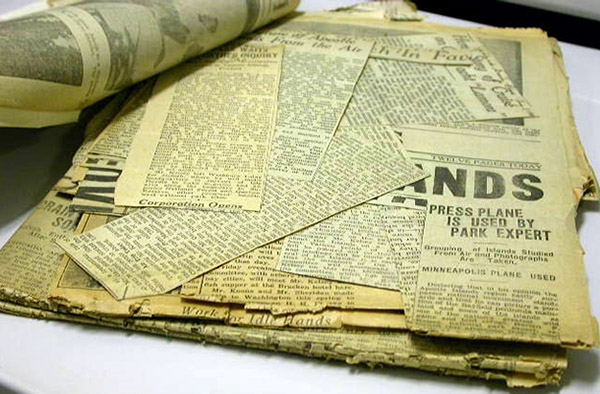

(Courtesy of Mary Lynn Ritzenthaler)
Despite the proliferation of online newspapers and news sources, something about printer's ink on a piece of paper makes it worthy of keeping.
Whether it is a small clipping describing a Little League homerun or a marriage announcement—or the entire front page of a newspaper reporting the winner of a presidential election or the landing on the moon—people collect newspapers and clippings.
Most newspapers printed in the United States since about 1850 are on poor-quality paper that was not made with preservation in mind. This type of paper, known as ground wood or mechanical wood pulp paper, contains impurities and tends to become discolored, brittle, and acidic over time. As such paper ages, it also becomes weaker and can easily tear when handled, especially along fold lines.
Attempting to preserve newspapers for posterity has been a major challenge for libraries and archives, since it is essentially fighting nature to try and preserve materials that are ephemeral. In the past, newspapers were microfilmed; now, digitization has superseded microfilming in most instances, and electronic publishing will likely eliminate that need in the future.
However, that still leaves newspapers and clippings that are found in personal collections that people wish to keep. What to do?
Storage: Store newspapers where it's cool and dry. Damp conditions can encourage the growth of mold and attract insects. Hot conditions can accelerate the yellowing and embrittlement of newspaper clippings.
Handling: Handle newspapers and clippings carefully to avoid chips of brittle paper breaking off. Make sure your hands are clean and have no lotions that could leave stains. Carefully open folded newspapers. Do not back-fold to flatten them (which can cause paper to break along foldw lines). Stop if your efforts seem to be causing damage. Do not mend torn paper with any kind of glue or tape.
Housing: Place clippings and full sheets in good-quality folders and boxes that fully enclose them. Full-sized sheets should be stored flat; attempts to fold them will likely cause them to break into pieces. Clippings can be stored upright or flat in folders and boxes. Do not intermingle newspaper clippings with letters, photographs, or other documents since the impurities in the newsprint will cause staining in adjacent materials. Clippings tucked into books, such as Bibles, can result in acidic stains that match the outline of the clipping; these stains are permanent. Placing newspaper clippings in clear polyester sleeves will permit safe handling of brittle clippings while separating them from other items in your collection. Sleeved clippings should not be placed in books, however, because the added bulk can damage bindings.
Display and sharing: Light exposure will cause poor-quality newsprint to darken and become brittle. You can see this change over a few days if a newspaper is left outside in the sunlight. So it’s important to store newspapers in the dark and to avoid displaying originals. Use a copy for display instead. If you have a digital scan, you can print it for display as well as share it with other family members. To prevent damage during imaging, use a hand-held digital camera or a scanner that can fully support your newspaper (no overhanging and no auto-feed!). To ensure long-term access to electronic versions of clippings, store files on the hard drive of your computer (not on compact discs) and have other family members keep back-up copies.
Mary Lynn Ritzenthaler is chief of the National Archives Conservation Laboratory.
Articles published in Prologue do not necessarily represent the views of NARA or of any other agency of the United States Government.